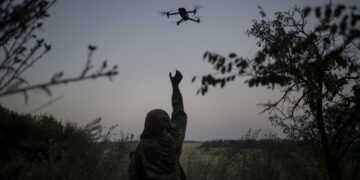The conflict in Ukraine has ignited a technological revolution, leaving its mark on both established states and burgeoning startups across Europe. This war has shattered the established order, altering the lives of millions and causing ripple effects, including Europe's largest refugee crisis since World War II, shifts in political alliances like Finland and Sweden‘s move toward NATO, and a surge in energy and food costs. Amidst these transformations, one of the most noteworthy changes has been technological.
The conflict in Ukraine has spurred innovation in the defense industry, with Western nations investing billions in weaponry. The evolution is particularly evident in drone warfare, now a critical tool in both Moscow and Kyiv's arsenals. According to Fortune Business Insights, the global military drone market is projected to grow from €13.3 billion in 2023 to €33.4 billion in 2030.
Kyiv is allocating approximately €1 billion to enhance its drone combat capabilities as part of a robust counteroffensive. Marduk Technologies, known as the “bad drone hunter,” has developed the “Marduk Shark,” a mobile system capable of detecting, tracking, and neutralizing drones within a 5 km range. This technology's evolution is impressive, considering that Marduk initially pioneered “electro-optical” devices to detect drones that didn't rely on radio signals.
While significant strides have been made, there are still formidable challenges in effectively countering drones. Issues such as the high cost of anti-drone missiles compared to drones themselves remain unresolved.
Another notable technological advancement is the deployment of unmanned ground vehicles, also known as robots. Milrem Robotics has developed 15 robotic systems since 2013, with applications in 16 countries, including Ukraine and NATO members. Their “TheMis UGV” is a swift and silent remote-controlled robot used for tasks like bomb disposal and intelligence gathering.
Despite these technological advances, they currently serve to assist rather than replace frontline troops. The technology is yet to reach a stage where it can fully replace human personnel.
The pace of technological change remains rapid, driven by the urgency of the conflict and the need to develop countermeasures swiftly. Russian forces are adept at devising countermeasures to Ukrainian technological innovations, perpetuating a continuous cycle of adaptation.
The Russian invasion of Ukraine has also sparked a surge in creative talent entering the defense technology industry, particularly in nations like Estonia, which shares a border with Russia. The significance of the defense industry has been amplified, and young innovators are increasingly drawn to this sector.
Perhaps the most profound impact of the conflict is the shift in military and governmental attitudes toward technology. NATO launched the Defense Innovation Accelerator for the North Atlantic (DIANA) in 2021 to foster disruptive technologies. Military clients have become more open and precise in articulating their needs, making collaboration and innovation more accessible and essential in the evolving landscape of defense technology.











